
Tripe is a type of edible lining from the stomachs of various farm animals. Most tripe is from cattle, pigs and sheep.

Offal, also called variety meats, pluck or organ meats, is the internal organs of a butchered animal. The word does not refer to a particular list of edible organs, and these lists of organs vary with culture and region, but usually exclude skeletal muscle. Offal may also refer to the by-products of milled grains, such as corn or wheat.
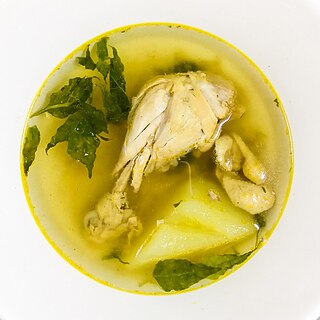
Tinola is a Filipino soup usually served as a Main course with white rice. Traditionally, this dish is cooked with chicken or fish, wedges of papaya and/or chayote, and leaves of the siling labuyo chili pepper in broth flavored with ginger, onions and fish sauce.
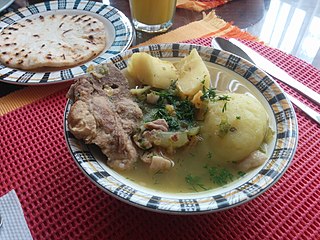
Sancocho is a traditional stew in several Latin American cuisines. Variations represent popular national dishes in Dominican Republic, Colombia, Cuba, Nicaragua, Mexico, Ecuador, Panama, Puerto Rico, Trinidad and Tobago, and Venezuela. It usually consists of large pieces of meat, tubers and vegetables served in a broth.

Kare-kare is a Philippine stew that features a thick savory peanut sauce. It is generally made from a base of stewed oxtail, beef tripe, pork hocks, calves' feet, pig's feet or trotters, various cuts of pork, beef stew meat, and occasionally offal. Vegetables, such as eggplant, Chinese cabbage, or other greens, daikon, green beans, okra, and asparagus beans, are added. The stew is flavored with ground roasted peanuts or peanut butter, onions, and garlic. It is colored with annatto and can be thickened with toasted or plain ground rice. Variations of kare-kare can be made with seafood, such as prawns, squid, and mussels, or exclusively from vegetables.

Poke is diced raw fish served either as an appetizer or a main course.

Pinakbet is an indigenous Filipino dish from the northern regions of the Philippines. Pinakbet is made with a variety of mixed vegetables flavored with bagoóng. The word is the contracted from the Ilokano word pinakebbet, meaning "shrunk" or "shriveled."
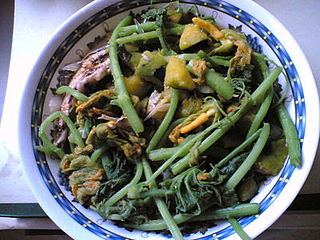
Dinengdeng is a dish of the Ilocano people of the Philippines, similar to pinakbet. It is classified as a bagoong soup-based dish. Unlike pinakbet, dinengdeng contains fewer vegetables more soup base.

Kaldereta or caldereta is a goat meat stew from the Philippines. Variations of the dish use beef, chicken, or pork.
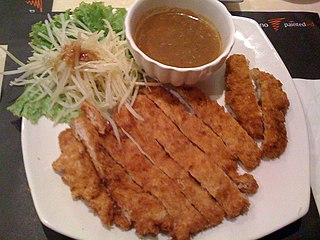
Chicken katsu, also known as panko chicken, or tori katsu is a Japanese dish of fried chicken made with panko bread crumbs. It is related to tonkatsu, fried pork cutlets. The dish has spread internationally and has become a common dish served at Japanese and East Asian restaurants worldwide.

Inihaw, also known as sinugba or inasal, are various types of grilled or pit-roasted barbecue dishes from the Philippines. They are usually made from pork or chicken and are served on bamboo skewers or in small cubes with a soy sauce and vinegar-based dip. The term can also refer to any meat or seafood dish cooked and served in a similar way. Inihaw are commonly sold as street food and are eaten with white rice or rice cooked in coconut leaves (pusô). Inihaw is also commonly referred to as Filipino barbecue or (informally) Pinoy BBQ.

Menudo, also known as ginamay or ginagmay, is a traditional stew from the Philippines made with pork and sliced liver in tomato sauce with carrots and potatoes. Unlike the Mexican dish of the same name, it does not use tripe or red chili sauce.
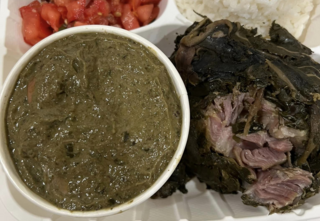
Lūʻau, Luʻau, Laulau, Lū, Rourou, Rukau, Fāfā, Hāhā, and Palusami are all related dishes found throughout Polynesia based on the use of taro leaves as a primary ingredient. While taro generally is known as a root vegetable for its starchy corms, the leaves are consumed as well. The base recipe is vegetarian. Most often, coconut milk was added, and later meat or seafood. The texture of the dish range from a thick soup to a dense cake.

Kilawin is a Filipino dish of chopped or sliced meats, poultry, seafood, or vegetables typically eaten as an appetizer before a meal, or as finger food with alcoholic drinks.

Afritada is a Philippine dish consisting of chicken, beef, or pork braised in tomato sauce with carrots, potatoes, and red and green bell peppers. It is served on white rice and is a common everyday Filipino meal. It can also be used to cook seafood.
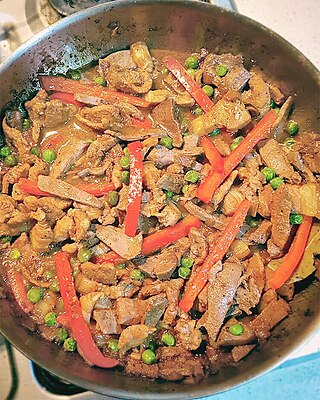
Igado is a Filipino pork dish originating from the Ilocos Region in the Philippines. Its name means "liver" in Spanish for which it features, although it may include other pork meats and offal also.

Taegu is a popular side dish in Hawaii related to Korean ojingeo-chae-bokkeum. It was perhaps introduced to Hawaii by the Koreans in the early 1900s. Taegu is often sold next to poke in the seafood counters of grocery stores and Korean specialty shops.
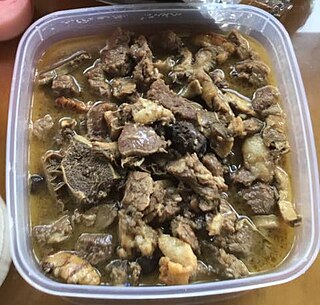
Pinapaitan or papaitan is an Filipino-Ilocano stew made with goat and offal and flavored with its bile, chyme, or cud. This papait gives the stew its signature bitter flavor profile or "pait", a flavor profile commonly associated with Ilocano cuisine. Similar to other Ilocano meat dishes, pinapaitan does not contain any vegetables other than those used for flavoring such as ginger, shallots, or chilis.
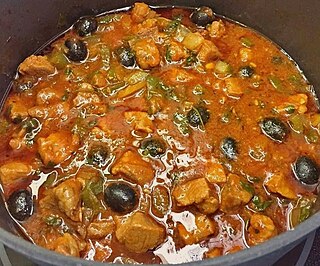
Pastele stew is a Hawaiian pork stew of Puerto Rican origin. It is an adaptation of the dish pasteles introduced by the Puertorriqueños who came to work on the sugar plantations in the early 1900s. Pastele making is often a laborious task reserved for special occasions and holidays such as Christmas. Pastele stew was developed as a simplified everyday version.



















